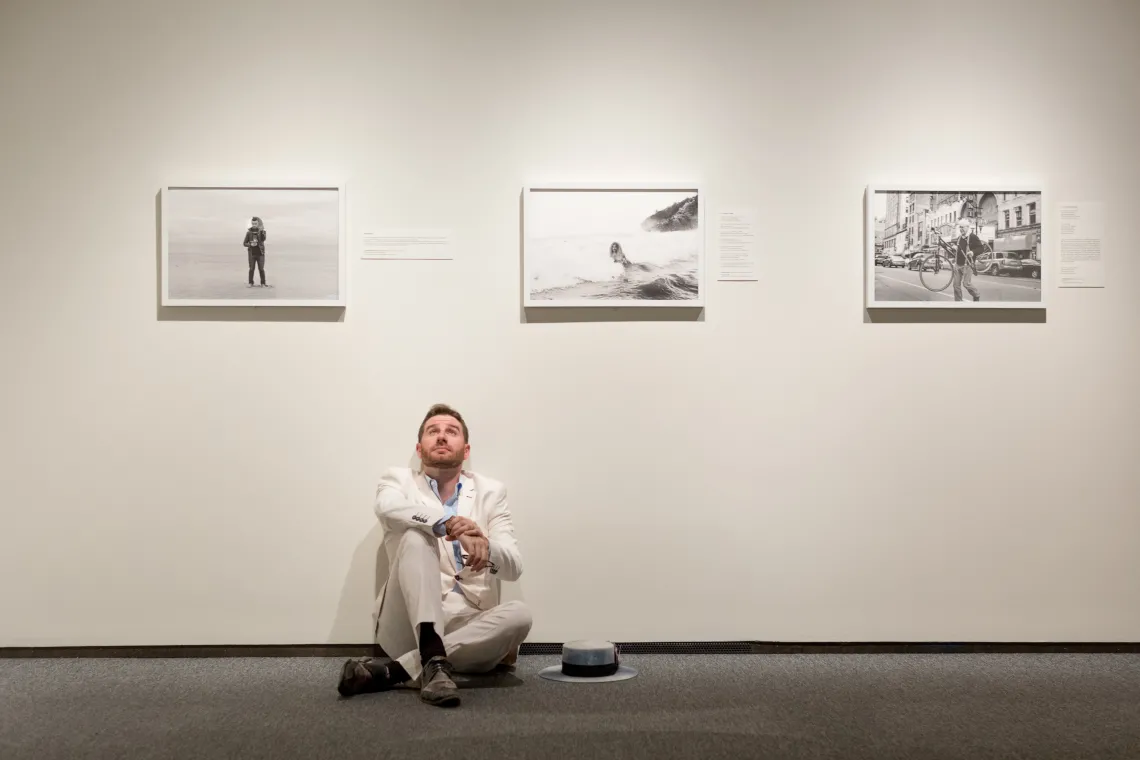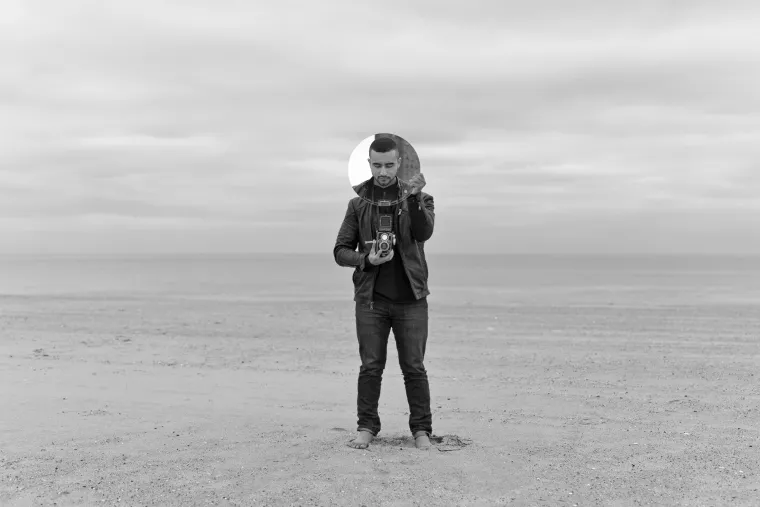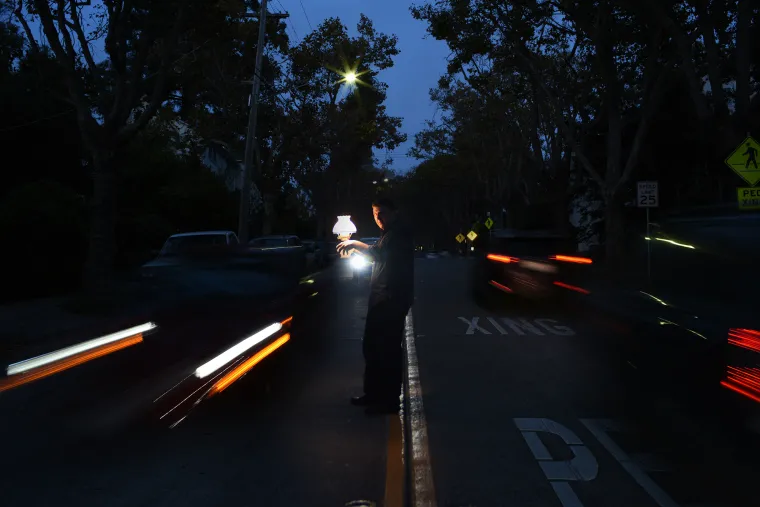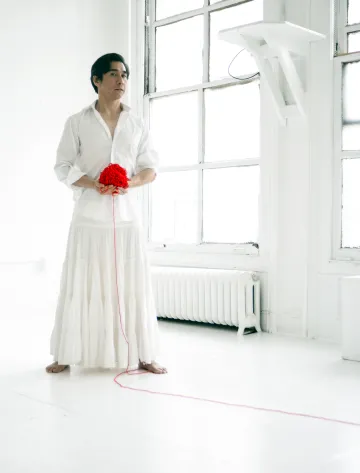Portrait of Poetry
A show by B.A. Van Sise

B.A. Van Sise / Chris Richards photo
Photographer B.A. Van Sise was nervous when he traveled to North Carolina to photograph renowned poet Dorianne Laux.
Van Sise, whose ancestor was 19th-century poet Walt Whitman, had just embarked on a project to create photo portraits of a range of contemporary poets, from Pulitzer Prize winners to those who write only on Instagram and from poet laureates to slam poets. Laux was one of the famous ones, author of five books and winner of the Pushcart Prize and a slew of fellowships — a poet Van Sise had admired, he says, “since I was 13 years old.”

Image: B.A. Van Sise, “Joan Kane,” courtesy of and © B.A. Van Sise
Each portrait in the project is based on a poem written by the sitter. For Laux’s photo, Van Sise planned to focus on “As It Is,” a poem that begins “The man I love hates technology […] / He wishes he lived in the old world, / sitting on a stump carving a clothespin.”
He planned to photograph Laux in that “old world,” in front of a crumbling farmhouse, so the pair had to meet for the first time in the remote countryside.
Both parties were uneasy.
“Dorianne was nervous to meet me, because I could be a crazy ax murderer, and I’m nervous to meet her because she’s Dorianne,” Van Sise recalls. “But we ended up traipsing around for hours through the North Carolina mud and forest and brambles. We had the greatest time.”
Van Sise got exactly the picture he had imagined. Now hanging in the Portrait of Poetry exhibition at the University of Arizona’s Center for Creative Photography — a show put on in collaboration with the UA Poetry Center — the black-and-white image captures both old and new. A carefree Laux relaxes outdoors in an easy chair, a ruined farmhouse behind her, the whole illuminated by an incongruous television set on the grass, lit up, Van Sise says, by “magic.”
Thrilled with the results of the collaboration between poet and photographer, Van Sise says, “I realized there was poetry in this too.”

Installation view / Chris Richards photo
The Making of the Portrait of Poetry Exhibit
About 80 of Van Sise’s photo portraits, along with a video of acclaimed poet Sharon Olds, are on view at the CCP in a sumptuous six-month exhibition.
The directors of the two UA centers are delighted to be cosponsoring a show for the first time.
“This is a very special project for us,” says Anne Breckenridge Barrett, executive director of the CCP. “We want to open our doors and take advantage of all the university’s resources. Both the Poetry Center and the Center for Creative Photography have unparalleled collections.”
Barrett met Tyler Meier, executive director of the Poetry Center, shortly after she arrived on campus to lead the CCP in early 2018. “We hit it off,” Barrett says. “We said that we needed to form a way to collaborate.”
Initially, Meier reached out to Van Sise about the possibility of an exhibition in the poetry building. But given the number of images involved, says Meier, “It was clear we couldn’t do it. We don’t have the wall space.”
So, not long after their first meeting, Meier called Barrett and related the tale of the photographer related to Whitman who had made quirky and beautiful photos of contemporary poets.
Barrett and Chief Curator Rebecca Senf looked at the images and were smitten. The CCP even had a time slot in the exhibition schedule to show the large collection — and it happened that they could open the show on May 31, the 200th anniversary of Whitman’s birth.

Left: Image: B.A. Van Sise, “Javier Zamora,” courtesy of and © B.A. Van Sise. Right: Image: B.A. Van Sise, “Matthew Zapruder,” courtesy of and © B.A. Van Sise

Left: Image: B.A. Van Sise, “Javier Zamora,” courtesy of and © B.A. Van Sise. Right: Image: B.A. Van Sise, “Matthew Zapruder,” courtesy of and © B.A. Van Sise
“B.A.’s photos are not conventional portraits,” Senf says. “His approach embeds something in the poet’s practice. That’s very interesting to me. And I appreciate his layers of construction: the costuming, the physical body, the environment.”
From the CCP’s deep archive, Senf was able to pull out some companion images to display in the adjacent Heritage Gallery. In the 1940s, revered photographer Edward Weston was commissioned to create photos of America to be included in a deluxe new edition of Whitman’s “Leaves of Grass.” The original photos, now part of the center’s collection, record the photographer’s cross-country journey through the U.S.
The Van Sise images are on display at the CCP through Nov. 23, with the sitters’ poems hanging alongside the photos. Six poetry readings are scheduled for the fall, alternating between the two centers, with younger poets appearing at the Poetry Center and more established poets at the CCP. Other events will take place off campus over the summer.
“We hope poetry regulars will come to the center to explore the photographs,” Senf says, “and that photography people might find something in the poems that inspires them.”

Image: B.A. Van Sise, “Joseph Legaspi,” courtesy of and © B.A. Van Sise
A Visual Portrayal of a Mix of Poets
At the Poetry Center, an enthusiastic Meier says that the show is an “authentic portrait of the landscape of poetry at this moment. It’s a giant cross section. Van Sise has done an admirable job.”
The images, he says, are beautiful — and sometimes weird and often provocative.
Rita Dove, an African American and former poet laureate of the U.S., is photographed in front of Monticello, home of the slave-owning Thomas Jefferson. Joy Harjo, whom Meier calls “one of our most important Native American poets,” is in a cafe, sharing a table with a horse — an animal that often appears in her work. Harjo was recently named U.S. poet laureate and is the first Native American to hold the title. Robert Hass, also a former U.S. poet laureate and a Pulitzer Prize winner, is pictured stealing a bicycle.
The mix of poets, including some well known and others less so, and the sometimes strange images in the photos, reflect Whitman’s expansive view of poetry, Meier believes. Often called the “father of free verse,” Whitman challenged the old, rigid rules of poetry, favoring poetry that didn’t rhyme and didn’t conform to meter. He also broadened the scope of topics that poets could write about.
“He created a possibility that didn’t exist before,” Meier says, adding that “the wild and exciting poetry of today” owes a lot to Whitman’s legacy.
Van Sise says his project is only partly inspired by his illustrious ancestor.
“I’m a great-whatever nephew. He was born 200 years ago. He doesn’t come to my parties,” Van Sise quips. “We’ve never met.”
However, Van Sise did develop an early passion for poetry. “I used to go into high school early and write poems on the blackboard in the morning,” he says.
Growing up to be not a poet but a photographer, he’s worked for magazines and newspapers (as Whitman also did). A few years ago, realizing that 2019 would mark Whitman’s 200th birthday, Van Sise decided that it would be interesting to do “poetic portraits of poets” to celebrate the literary descendants of Whitman.
Calling the project “Children of Grass” — in honor of “Leaves of Grass,” arguably the most significant of Whitman’s works — Van Sise wanted to make images that were as free-form as his ancestor’s renowned free verse.
“I reached out to about 15 poets,” he says, telling them that “I want to have fun. I want to make portraits that are visual, that reflect your work.”
Once they said yes, Van Sise studied up on their poems. “I’d come back to the poet and I’d say, ‘Here are my ideas.’ That’s where it got collaborative. A lot of times poets would push back and say, ‘I don’t like this idea,’ or ‘Hey, this idea is great — but it could be crazier.’ For the most part, the poem selections were mine, but the images were fairly collaborative.”
Early on, after positive experiences with Laux (the third poet he photographed) and other subjects, Van Sise decided to expand the project well beyond the original 15.
He asked each of his subjects to recommend other poets, both obscure and famous, whose work deserved attention. Their recommendations turned the project into a snapshot of what American poetry looks like now and led to an exhibition that places young Instagram writers and Pulitzer winners side by side.
Van Sise’s rainbow of writers reminds Meier of a famous poem in which Whitman championed multiplicity and contradictions.
“Do I contradict myself?” Whitman asked in “Song of Myself.” “Very well then I contradict myself, / (I am large, I contain multitudes).”
